"Every employee is key to your business and worthy of care. Every employee is instrumental to the growth and sustainability of your business. Your company should be instrumental to their growth and well-being."
Nationwide, across all companies, the employee experiences factor has undergone a paradigm shift with continuous evolvement, especially after the pandemic hit the world. Every nine out of ten employers focus on enhancing their workers' experience. Reason - a positive employee experience ends up in higher productivity, better retention of high talents, a supportive environment, and improved company growth.
Post-pandemic, the mindset of employees is different. There is a huge expectation of monetary and non-monetary privileges. More specifically, GenZ workers want a conducive and productive work environment that helps them grow and learn to their true potential. They also want a deep connection, belonging, and purpose with their organization. This is attached deeply to a social sense. Hence, most companies globally have started implementing the best HR software tools that help top management create employee-centric policies and augment employee engagement, experience, and retention based on factual information.
This article highlights the importance, strategies, and the latest employee experience trends.
What Is Employee Experience?
Employee Experience is an employee's perception of his/her journey in an organization from pre-recruitment to post-exit, including interaction with employers, milestones, individual growth, comfort in the work environment, and technology support. In other words, employee experience translates employee happiness and comfort into day-to-day well-being professional relationships.
“The vision is really about empowering workers, giving them all the information about what's going on so they can do much more than they've done in the past.” -Bill Gates
Today, companies are paying more attention to providing quality employee experience to foster flexible and robust work culture.
Why Is Employee Experience Vital For Building Positive Work Culture?

Employee experience is crucial in how employees feel about the establishment's purpose, motive, and practice. Happy employees create a healthy workspace for everyone to work together and achieve optimal results. Therefore, it becomes pivotal to strike the right balance between them.
Employee experience significantly impacts different aspects of a business, as explained below:
Creates a robust work culture
HR leaders must constantly stay updated about recent developments and trends to bring necessary changes in company policies and make them more employee-friendly. An agile and flexible workplace catches the attention of more candidates for the right reasons. Organizations that want to inculcate company culture and values among their employees need to provide an aligned employee experience that reflects those values and culture.
Improves the collaboration process
Effective communication can resolve half of the issues. Collaborative work demands continuous communication between parties for recent updates and clarity about the final product. This process cultivates teamwork and professional connection among employees, making the workplace nonchalant. Organizations can use collaboration software, allowing employees to collaborate on projects, strategize tasks, improve scheduling, etc. Effortless collaborative work creates a new experience for employees to groom themselves.
Increases overall productivity
As per 'Happiness and Productivity' research, happy employees are 12% more productive than others. Leading by example, Google invests heavily in employee experience and engagement, which has helped the company increase its productivity level by 37%. Also, tools like productivity software increase efficiency, better accuracy, and improve collaboration. Such an environment reduces stressful situations and allows them to have space to cultivate at their pace. Employee experience directly impacts employee engagement, dedication, and efficiency toward work.
Appeals to and retains talented employees
A supportive work environment leaves a lasting impression on employee mindset. Organizations with a healthy work culture earn employee loyalty as they let employees concentrate on their individual growth. Employees want to stay longer with an organization where their interests and principles are aligned with a sense of belonging. Companies also need to focus on professional development and allow them to explore a new trajectory where they can excel better.
It focuses on employee well-being
Employee mental health at the workplace is one of the topmost trends for 2023. Since the pandemic, the work culture has undergone a massive shift, depending on the different phases. Assurance in the form of health benefits, such as medical insurance and financial aid during emergencies, makes employees feel wanted and valued. A viable model supporting work-life balance keeps employees refreshed and motivated, enhancing their overall creativity, productivity, and performance.
It enhances customer relationships
Happy employees keep customers happier. Less complexity leads to quality work and allows employees to deliver their best to customers. Employees can amplify customer experiences smoother by using advanced tools and technologies. Employee experience is an integral part of new customer engagement. Also, valuable recognitions, such as employee of the month/year, attractive incentives, team players, etc., motivate employees to work to their full potential and develop a sense of competitiveness, which can help firms to achieve targeted goals.
Enhances the company's image
A positive and healthy workplace addresses employee support, satisfaction, and engagement. These pivotal elements help organizations to make a strong bond with employees. Employees stay longer where they feel appreciated, empowered, and celebrated. It decreases employee turnover due to high employee morale. Companies with less employee turnover can establish good reputational goodwill in the market, boosting their financial position.
Generates increased ROIs
“When the employee feels that the company is taking their interests to heart, then the employees start taking the company’s interest to heart." - Dr. Noelle Nelson (Author, Make Money By Making Your Employees Happy)
Employee experience has become one of the top priorities for companies due to the competitive market and gig economy. Organizations are calculating and measuring ROI on employee experience initiatives to get the best out of employees. The simplest formula to calculate ROX (Return on Experience) is considering all the pros of experience initiatives, dividing it by the amount invested in them, and multiplying it by 100. Also, tangible and intangible sources are required to measure the employee experience. Tangible and intangible employee benefits increase employee retention, productivity, customer satisfaction, etc. Consequently, companies achieve more incredible innovation and easier recruitment. It improves profit margins and reduces expenses, inviting more investors, stakeholders, and shareholders.
What Are The Stages Of The Employee Life Cycle?
The employee life cycle is a model for identifying different stages of employee involvement throughout their journey with an organization. Every employee passes through six chronicle stages: Attraction, Recruitment, Onboarding, Development, Retention, and Retirement. It is vital that employees feel valued at every step of the employee life cycle model. Hence, the HR department takes the support of various advanced tools such as HR Software, Payroll Software, Recruitment Software, Applicant Tracking Software, HRIS, etc.
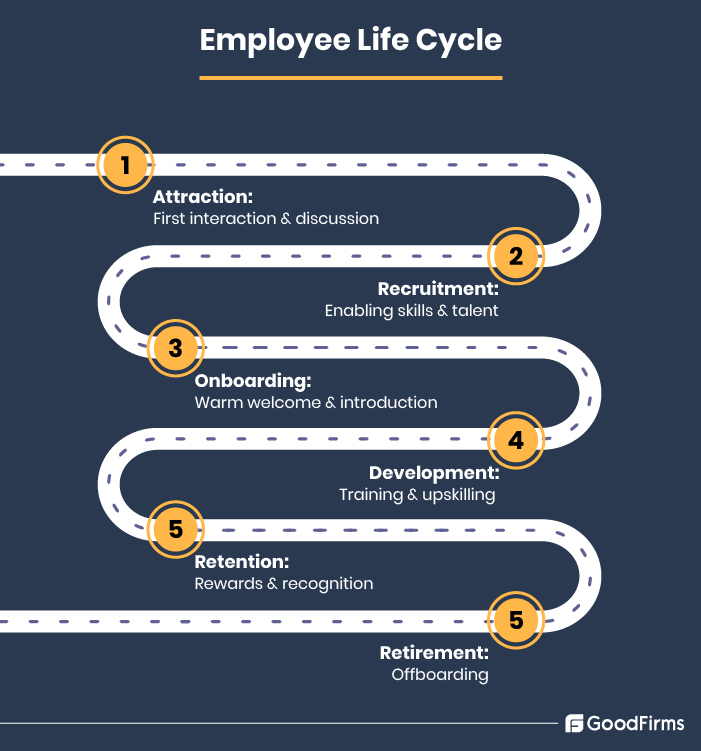
- Attraction: From the first point of contact through job marketing ads, candidates start judging employers. An appealing job marketing strategy leaves a lasting impact and invites more candidates. Prospective employees pay close attention to communication flow, interview process and negotiation strategy to understand flexibility and agility, which help them decide if they want to go ahead with a company.
- Recruitment: Candidates create a perception depending on the treatment during the interview, talent acquisition and offer management processes. Candidates appreciate employers who value their time and input, providing proper feedback and updating them. With proper communication, there are more chances of non-hired candidates to stay in touch and become a future employee.
- Onboarding: New employees prefer an easy and smooth onboarding process that doesn’t take them too long to adjust. Multiple organizations practice a work buddy strategy to ease the transition of new employees and welcome them with a well-informed induction process to get acquainted with company culture.
- Development: During the development process, employers and employees can create a deeper connection. A company’s investment in the career development process for its staff increases job security. It avoids career stagnation, motivating employees to challenge themselves and stick with the company for a long time.
- Retention: Employers must make employees feel valued and express gratitude to earn trust and loyalty. Employers show their positive intentions towards their team members by offering health care, career opportunities, feedback, achievement rewards, success celebration, etc., ensuring employees feel cared for during their time of need. It improves company employee morale and overall performance.
- Retirement: An employee’s journey ends in an organization when he/she retires from his/her designation. A non-troublesome departing process allows both parties to learn where they are lacking to provide the best, which can add value to their next job and still feel welcome at the previous workplace. Employees can channel the whole experience to cultivate his/her career.
10 Easy Strategies to Boost Employee Experience In 2023
The following trends of 2023 can help your organization to use a unique approach to enhance employee experience this year.
1. Encourage Diversity

Workplace diversity brings more ideas, experience, and knowledge to the table. A team with different cultures, genders, races, religions, backgrounds, ages, disability levels, etc., can ensure more success and better results by sharing perspectives, experiences, mindsets, and unique ideas with others. This multicultural organization encourages diversity, values, employees' skills and talent, making them feel like team players. Employees feel more connected to each other in a distinct way, amplifying the employee retention rate.
Example: For a diverse workplace, Starbucks is set to reach targeted numbers by 2025 in corporate and retail roles.
2. Proactive communication & Inclusion
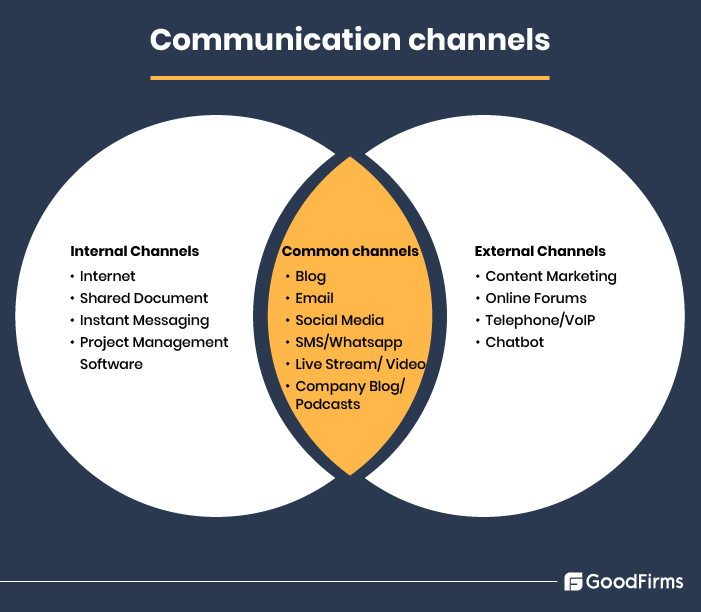
A transparent and open-minded office culture welcomes new thought processes and allows employees to dig deeper while striving for optimal results. Periodic meetings allow employees to get to know each other, understand each other's capabilities and create a space for everyone to speak their minds. Employees enjoy their work more when their leaders and managers open their doors for questions, suggestions, feedback, and conversations as they feel heard, cultivating trust in leadership. On the other hand, having a clear discussion with customers about workflow processes eliminates uncertainty and misunderstandings, removing unnecessary burdens from staff's shoulders.
Example: Netflix believes in making the most of employee interactions and that’s why the company meetings are used as a platform to learn something new from each other instead of discussing strategic moves like tactical decisions and error prevention.
3. Adapt The Latest Trends, Technology & Tools
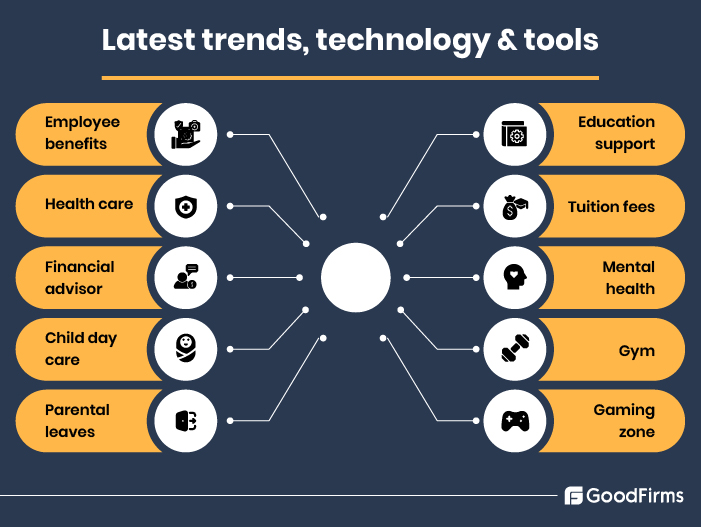
In this digital and technological age, companies are prioritizing more on smart work over hard work. It helps them to streamline and automate tasks by integrating advanced technology like AI, machine learning, and software tools. Also, it provides a common platform for employees to communicate and collaborate while working easily. In addition to these, future work trends, such as quiet hiring, hybrid flexibility, focusing on skills over jobs, widening skills gaps, etc., have gained more traction.
Example: Microsoft integrated the latest version of ChatGPT to deliver faster, more accurate and capable Bing chat services to users.
4. Offer Career Development
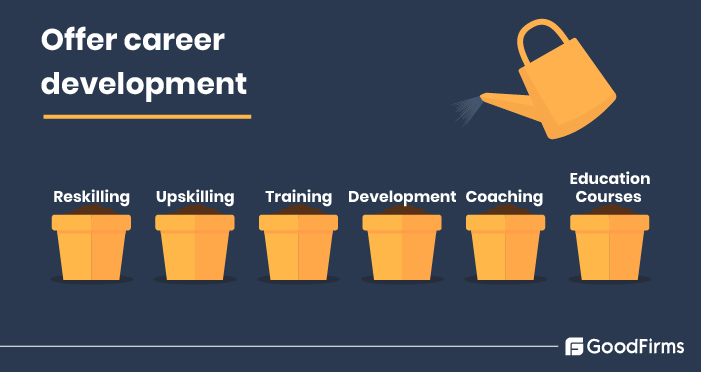
Skilled employees prefer challenging jobs that bring meaning to their work hours. These employees focus on constructing their best version and learning something new to stay relevant in the market. It is also seen as reskilling and upskilling the precautionary steps for the unseen future. Such programs avert talent shortage & workflow disruption, generate a reliable talent pool and career development. Multiple companies use various tools to recognize potential leaders to polish their skills through training, seminars, leadership development, etc.
Example: Morgan Stanley includes various educational and professional plans as a part of career development for their employees, such as the lead program, career management program, platinum program, etc.
5. Interactive Workspace
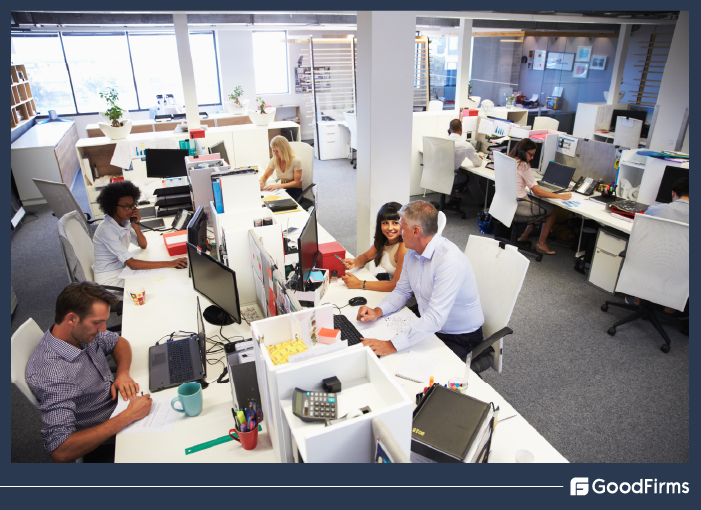
Employees spend ample time at the workplace, so it is mandatory for them to have healthy professional bonds. One of the sheer pleasures of working together is the ability to express, communicate and share. As per a report, one of the major strategies to improve employee experience is to promote having friends at the workplace. Employees working in teams must create strong dynamics through team bonding activities such as team meetings, games, lunch, breaks, etc. Besides, the annual gathering allows employees to recognize the star players of a company and get inspiration from their work style.
Example: Cisco’s ‘Connected Recognition’ program helps employees to work together and appreciate their good work by giving them worthy rewards.
6. Smooth Onboarding Process
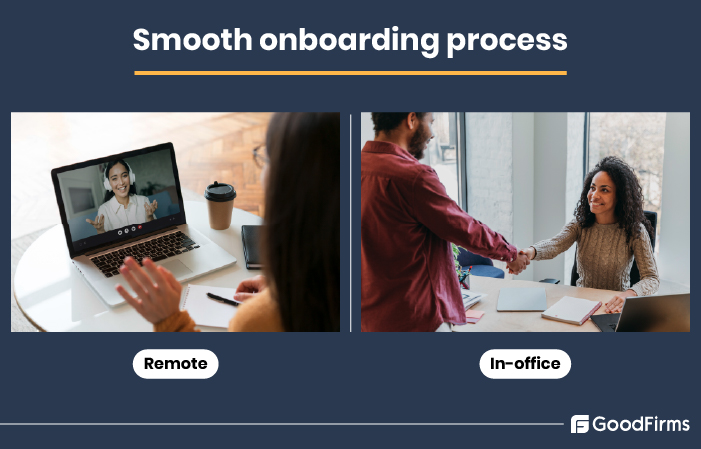
Poor onboarding experience pushes 80% of employees to leave their jobs in six months. This fact clearly indicates that a well-designed onboarding process supports organizations to have higher employee retention and employee experience. New joiners totally rely on the HR department to connect with others and feel comfortable, regardless of their job location. Hence, it is crucial to address the nervousness among new employees and make them feel like a part of the family. Employee orientation programs can help new employees to understand company goals, targets, hierarchy, workflow, leave policy, communication system, etc., for a smooth adaptation.
Example: Salesforce assigns a mentor to a new hire from the day of joining to help new employees grasp company culture.
7. Include Employee Wellness

Industries across the globe have started respecting the personal life of their employees. Firms have realized that employees must have sufficient time to cool off in order to give their best shot. Employees feel more drawn toward companies that emphasize employee physical and mental well-being. Healthy work-life balance directly affects employee experience, so employers thoughtfully plan activities around creating a balanced work culture. Such activities are namely nutritional lunch & snack programs, fitness programs, community services, employee assistance programs, health check-ups, meditation programs, mental health programs, etc.
Example: IBM takes employee wellness seriously and offers employees such programs by investing in safety, medical, health benefits and health promotion.
8. Healthy Employee Engagement
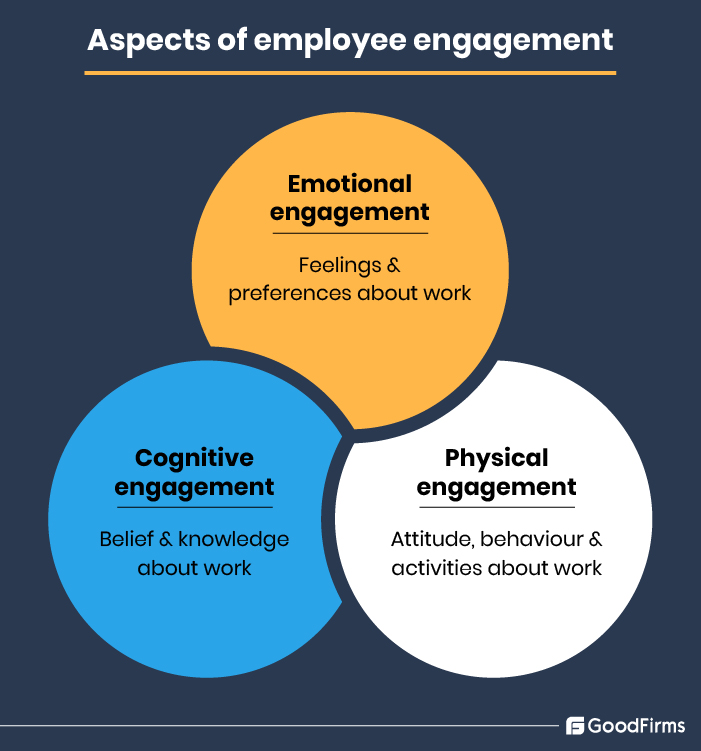
Employee engagement is one of the core challenges for the HR department. However, employee engagement solutions help them understand emotional, physical, and cognitive employee engagement to comprehend what works best for their organization and cope with the 'New normal.' Cognitive engagement focuses on job commitment, emotional engagement focuses on feelings toward a job, and physical engagement emphasizes physical activities and investment toward work. Companies should strategically plan employee engagement after understanding every employee's passion, requirements, and demands.
Example: Adobe is one of the first companies to invest in employee wellness programs such as travel support, pet service, personal and family services. In education benefits, the company supports its employees with a reimbursement of $10,000/year.
9. Comprehend & Enact Employee Feedback

Open communication can avoid the feeling of negligence and disrespect in employees. Organizations where employee feedback and surveys are taken seriously usually create psychological safety. Multiple survey tools can help companies to create different types of employee surveys and act upon the feedback leading to their continuous growth. Also, it allows the staff to learn from their mistakes instead of feeling insecure and belittled. Successful companies pay more attention to action plans by involving as many employees as possible and finding the right employee to get work done. There are six types of employee surveys; candidate feedback survey, employee engagement survey, employee benefits survey, onboarding survey, 360-degree survey, and exit survey.
Example: Microsoft employees can interact with the management through AskHR as a platform to discuss their workplace needs.
10. Set Clear Rules, Expectations & Targets
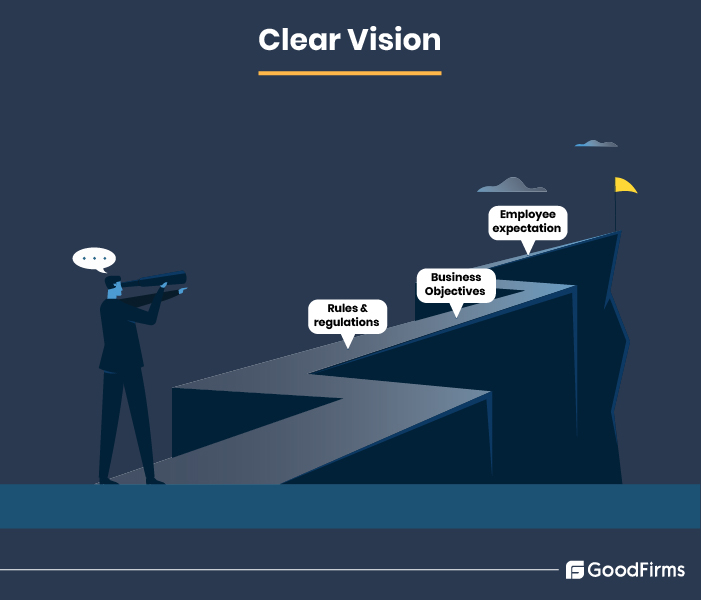
To reach the optimal level of productivity imperatively, employers need to have a clear vision of their dreams, expectations, and objectives. Such clarifications help employees break long-term targets into small goals, which becomes more feasible and accomplishable. The teamwork of leaders, managers, and employees makes it possible for an organization to achieve its purpose. Deciding the workflow, setting timelines, opting for a chosen working model, selecting the right technology, maintaining discipline, and giving roles and responsibilities become easy with the basics drawn out clearly. HR leaders can provide proper memos to follow protocols, rules, and regulations to achieve set expectations.
Example: With the mission to spread ideas, foster community and create impact, TED encourages 3000 employees to conduct events and raise funding for meaningful projects.
Latest Trends To Follow In 2023 For Enhancing The Employee Experience
The post-pandemic period has brought opportunities and challenges for employees and employers alike. Great Resignation and remote work adjustments have turned the global workforce upside down, but on the flip side, new and latest employee experience trends like the hybrid work model, employee wellness, investing in organizational culture, etc., have amplified productivity and improved the satisfaction level of employees.
These top most hits of 2023 can help organizations to develop an organized employee experience that also helps businesses to cultivate.
1. ChatGPT

ChatGPT has been making huge noise since its introduction at the end of 2022. A few call it as a "primer" for recruitments. The reinforcement learning model helps this AI-powered technology to improve over time and reduce manual and repetitive tasks. The HR department can optimize this advanced conversational AI for collecting and analyzing employee feedback, surveys, etc. It can easily navigate communication and collaboration in hybrid companies by answering commonly asked questions, explaining complex topics and outlining key points. It can regulate and boost customer experience with quick responses.
2. 4-day work week

Four-day workweek is a movement introduced by many companies to reduce employee stress levels and provide them with a better work-life balance. Several countries, like the UK, UAE, Japan, Belgium, Iceland, etc., have embraced this 4-day work week where the new working days are from Monday to Thursday. Also, more than 300+ companies are adopting a 4-day work week, providing full salary to their employees.
3. Hybrid model

The pandemic has allowed organizations to devise new working models where employees cannot be tied to their desks and workstations. It has given birth to a hybrid work model where employees can work from the office and home based on task urgency. Depending on the industry, many companies are earnestly working toward creating a combined balance of in-office and remote work experience environments, which can benefit both parties. Google, Nike, Target, J.P. Morgan, etc., are some of the top-notch companies that have adopted the hybrid work model. Google CEO Sundar Pichai has advocated that the future of work is hybrid.
4. Digital Workplace

The digital workplace is a modern version of a work environment that includes personalized and role-based services, data, applications, collaboration tools, etc., giving comfort to employees to work from anywhere, at any time, and from any device. Technology with agility and mobility streamlines business operations and creates harmony among employees. Companies can hire employees from across the globe and create a talented workforce.
5. Right To Disconnect Law

Multiple companies are addressing strict work hours due to the unclarity of personal boundaries in remote and hybrid models. It averts stressful and burnt-out feelings in employees as they will not be bound to answer to their superiors once they are off the clock. Since last year, Kenya and Portugal have started applying this technique to highlight personal and professional life importance and avoid working for extended hours.
6. Quiet hiring

Quiet hiring is slowly picking pace. Usually, companies find suitable talent internally (i.e., without hiring a new employee) or hire a part-time contractor/freelancer to complete a project. It allows employees to enhance their skills and knowledge, giving them an opportunity to demand more benefits like increments, additional leaves, extra breaks, etc.
These six modern-day trends connect employers with the young generation. Also, the recruitment team can leverage these tactics to attract new candidates.
Wrapping Up
“In a world where money is no longer regarded as the motivating factor, focusing on creating employee experience provides the most promising competitive advantage.” - Jacob Morgan, Author of The Employee Experience Advantage
Celebrating each employee is the key to success. For organizations planning to create an exceptional employee experience, the first vital element is identifying employee contributions and employee recognition. Employee recognition is one of the most powerful investments that a company can make to establish its dominance in this competitive marketplace. It allows employers to reach out to the right talent pool, help employees shape their careers, and improve the retention rate.



